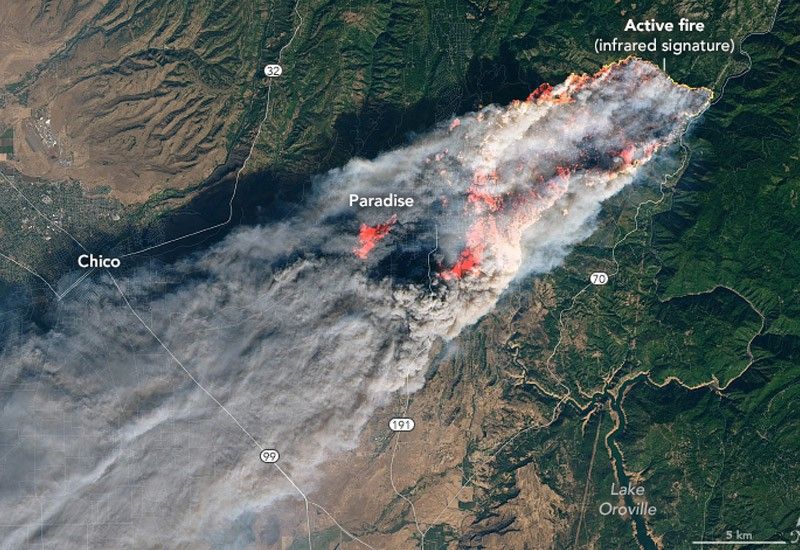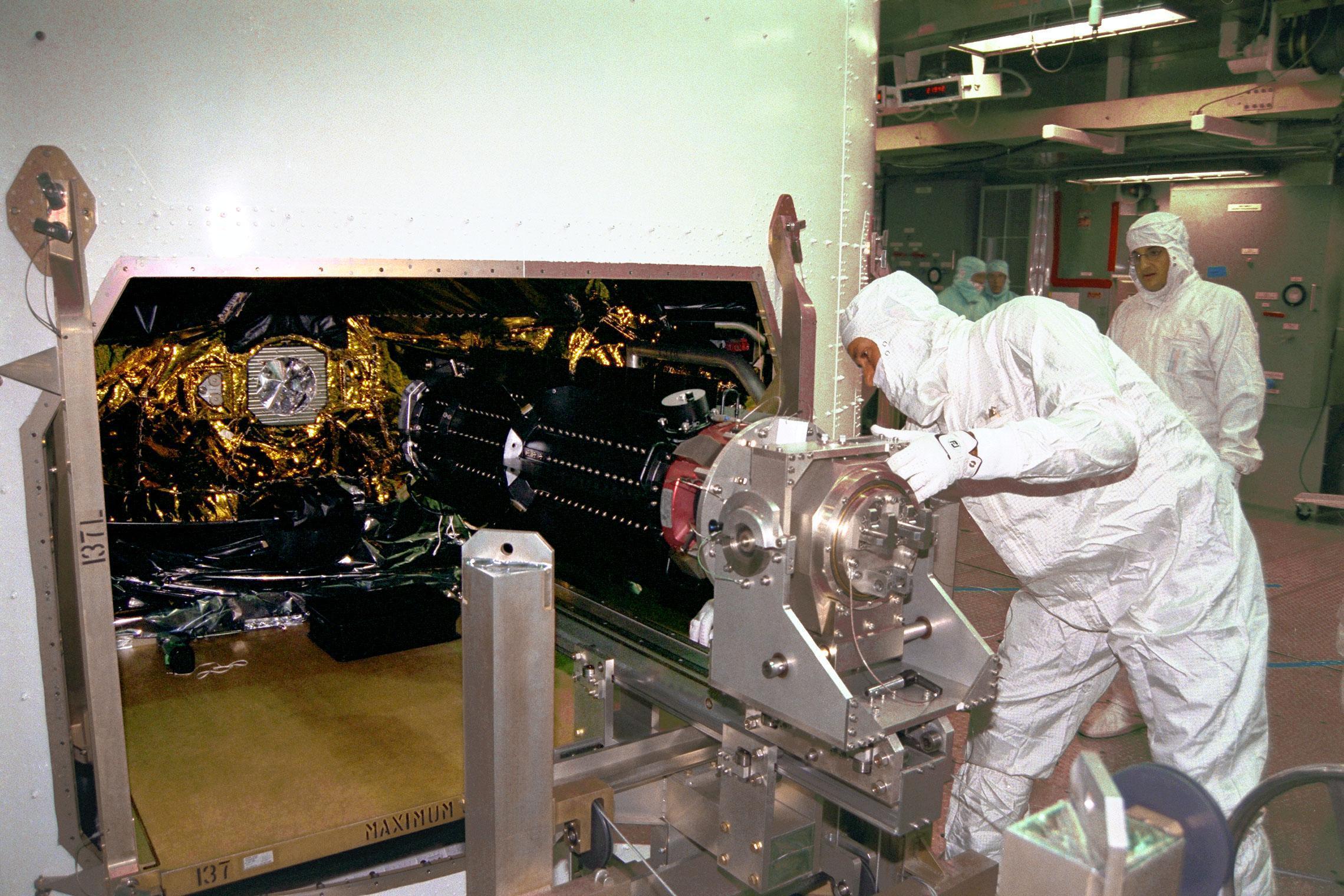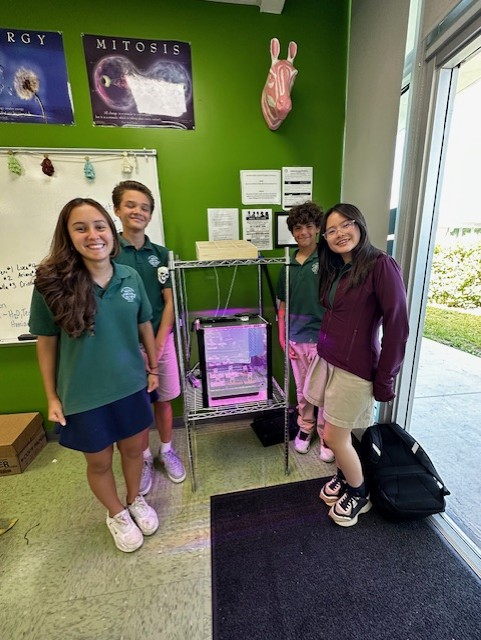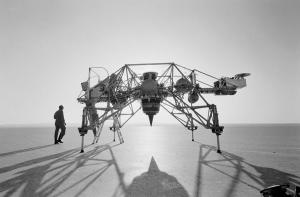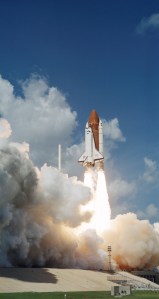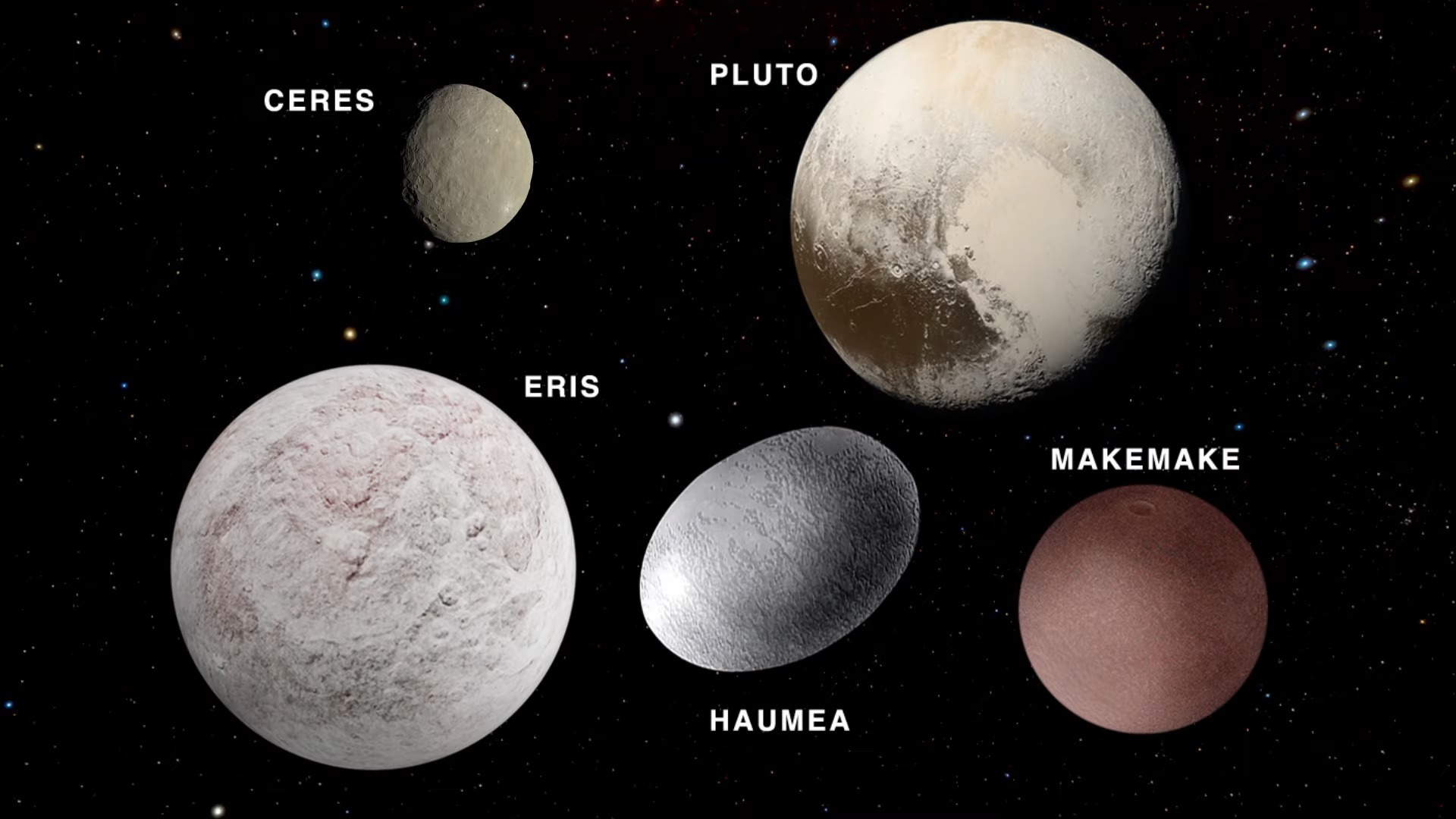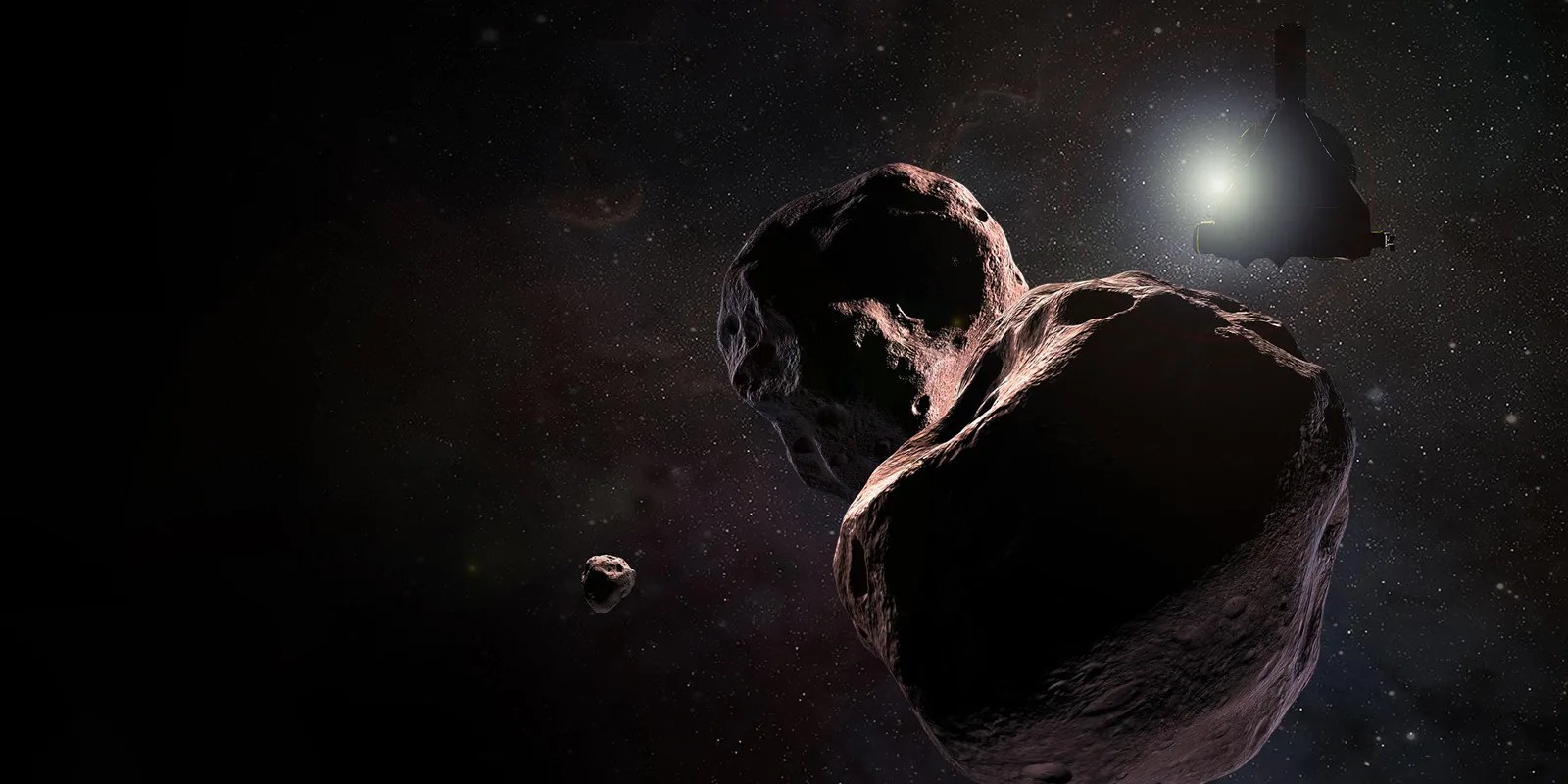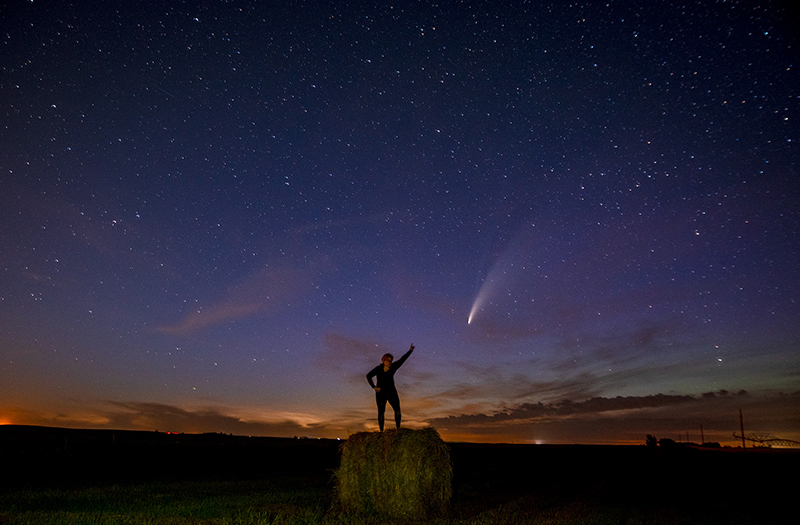By 1989, robotic spacecraft had visited all the known planets from Mercury to Neptune. That left only Pluto, then considered the ninth planet in the solar system, unexplored. NASA approved the New Horizons mission in 2001 to conduct the first flyby of the small distant planet and its large moon Charon and explore the Kuiper Belt of small icy objects that lay beyond. The spacecraft launched a little over five years later, on Jan. 19, 2006. Although already the fastest spacecraft to leave Earth, New Horizons also required a gravity assist from Jupiter to reduce its total flight time to Pluto from 14 years to under ten. On July 14, 2015, the spacecraft zoomed through the Pluto system, taking hundreds of photographs and returning scientific information about the little-known planet, its atmosphere, and its moons. On New Year’s Day 2019, New Horizons flew by the Kuiper Belt Object Arrokoth, at four billion miles away, the most distant encounter by any spacecraft.

In 1991, the U.S. Postal Service released a set of stamps to commemorate planetary exploration, with the caption under Pluto reading “NOT YET EXPLORED.” Credit: U.S. Postal Service.
In October 1991, the U.S. Postal Service unveiled a set of stamps celebrating NASA’s exploration of the solar system. The 10 stamps displayed images of the nine planets and Earth’s Moon, along with significant spacecraft that explored each one. The stamp for Pluto had an artist’s impression of what the planet might look like with the words “NOT YET EXPLORED” beneath the picture. Those three words became a rallying cry for scientists eager to complete the exploration of the solar system with a mission to Pluto. Their years-long effort finally paid off when on Nov. 29, 2001, NASA approved the New Horizons mission as a new start project, with Alan Stern from the Southwest Research Institute in Boulder, Colorado, as the principal investigator (PI). The Johns Hopkins University’s Applied Physics Laboratory (APL) in Laurel, Maryland, built and operated the spacecraft.
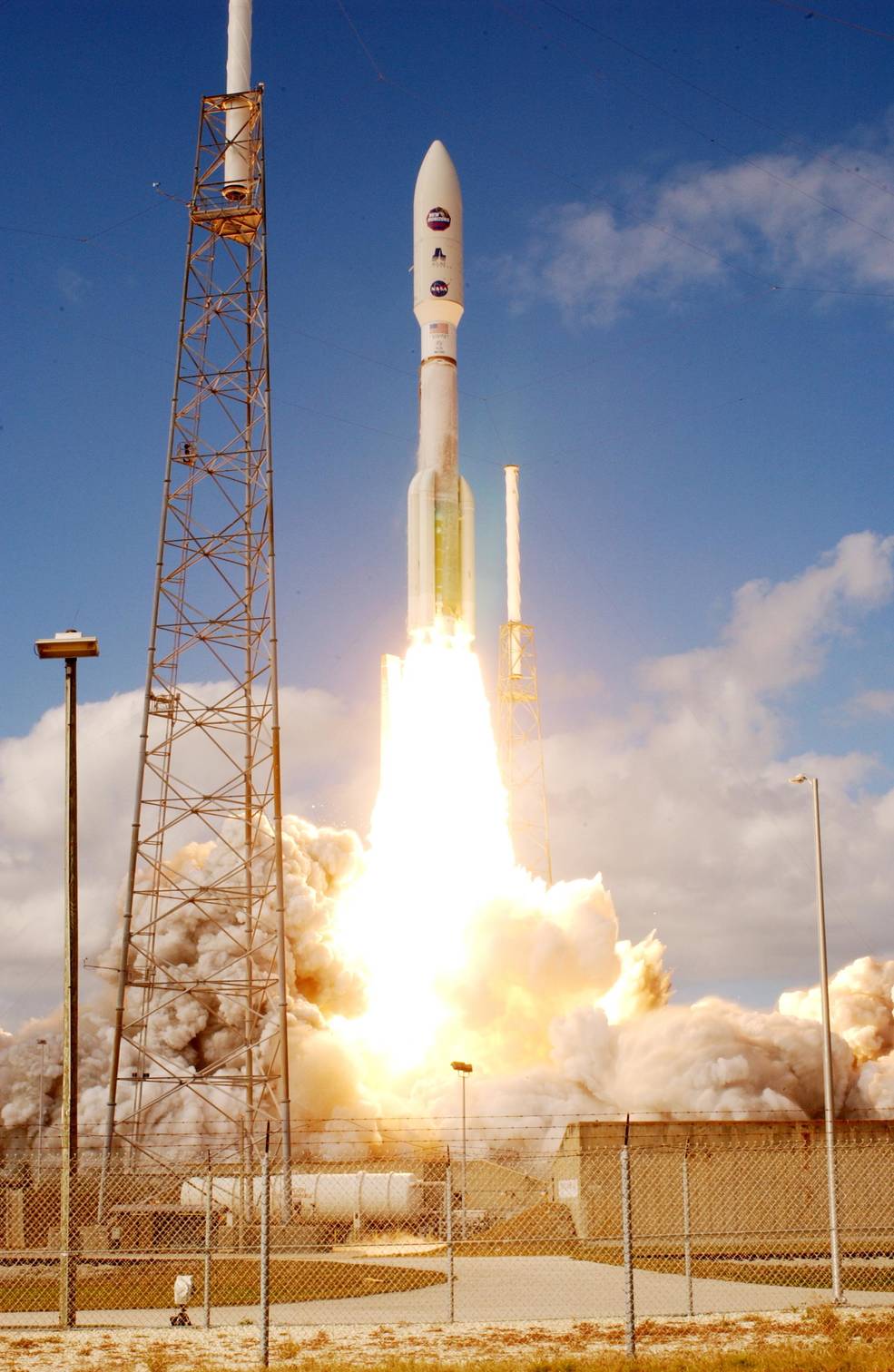
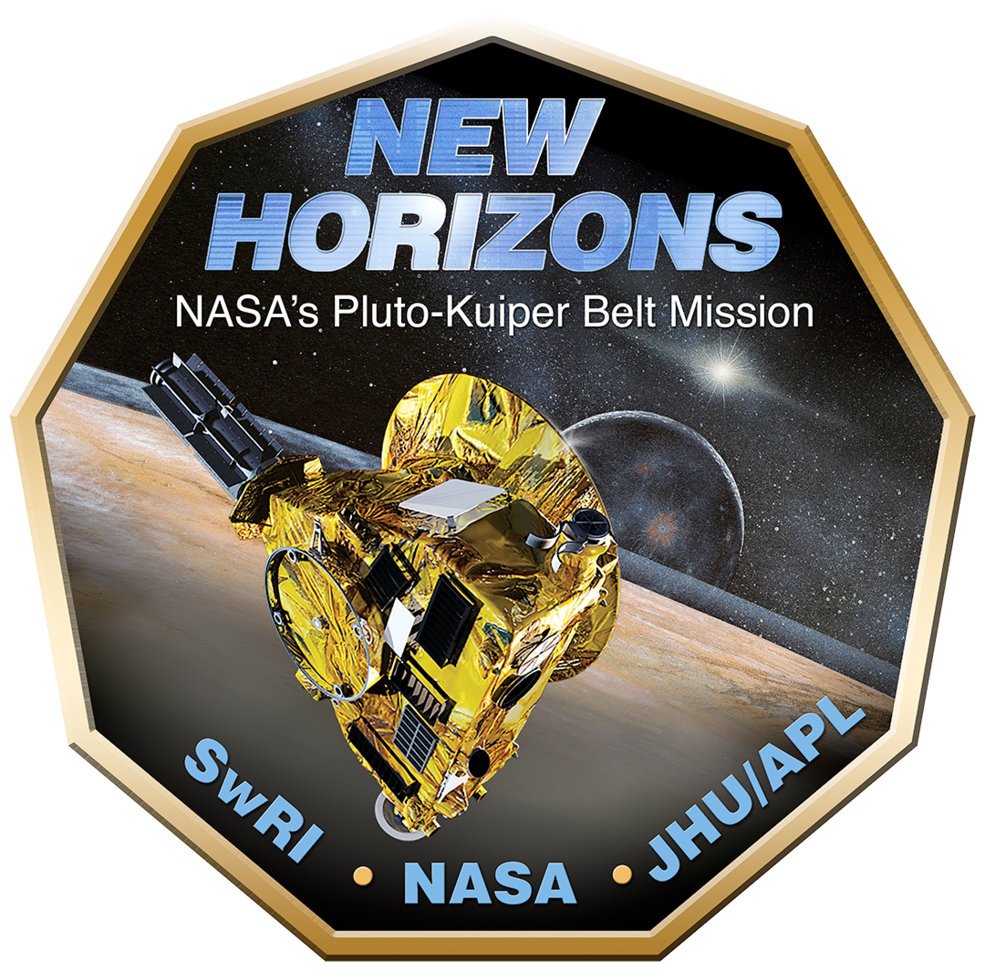
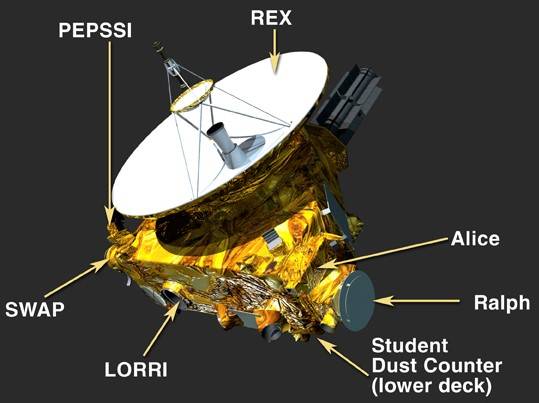
Left: The launch of New Horizons on an Atlas V rocket in 2006. Middle: The nine-sided New Horizons mission patch.
Right: Illustration of the New Horizons spacecraft highlighting its science instruments. Credits: NASA, Johns Hopkins University Applied Physics Laboratory, Southwest Research Institute.
Less than five years after selection, on Jan. 19, 2006, New Horizons lifted off atop an Atlas V rocket from Cape Canaveral Air Force Station in Florida, to begin its journey to Pluto. After the spacecraft achieved escape velocity, a STAR-48 solid-fuel upper stage accelerated the spacecraft to 36,000 miles per hour, making New Horizons the fastest spacecraft to leave Earth. It passed the Moon’s orbit in just nine hours, nearly 10 times faster than the Apollo astronauts, and began its nearly 10-year, 3-billion-mile journey to Pluto. To shorten an otherwise 14-year trip, New Horizons took advantage of a gravity assist from the giant planet Jupiter. During that flyby, scientists had a chance to test out the instruments that New Horizons planned to use to make the first close-up scientific exploration of Pluto. The science payload included seven instruments:
- Ralph: A visible and infrared imager and a spectrometer to generate color, composition, and thermal maps.
- Alice: An ultraviolet imaging spectrometer to analyze the composition and structure of Pluto’s atmosphere and to look for atmospheres around Charon and Kuiper Belt Objects.
- REX (Radio Science EXperiment): A passive radiometer to measure atmospheric composition and temperature.
- LORRI (Long-Range Reconnaissance Imager): A telescopic camera to obtain encounter data at long distances, to map Pluto’s far side, and to provide high-resolution geologic data.
- SWAP (Solar Wind Around Pluto): A solar wind and plasma spectrometer to measure atmospheric “escape rate” and observe Pluto’s interaction with the solar wind.
- PEPSSI (Pluto Energetic Particle Spectrometer Science Investigation): An energetic particle spectrometer to measure the composition and density of plasma (ions) escaping from Pluto’s atmosphere.
- SDC (Student Dust Counter): Built and operated by students, the SDC measured the space dust peppering New Horizons during its voyage across the solar system.
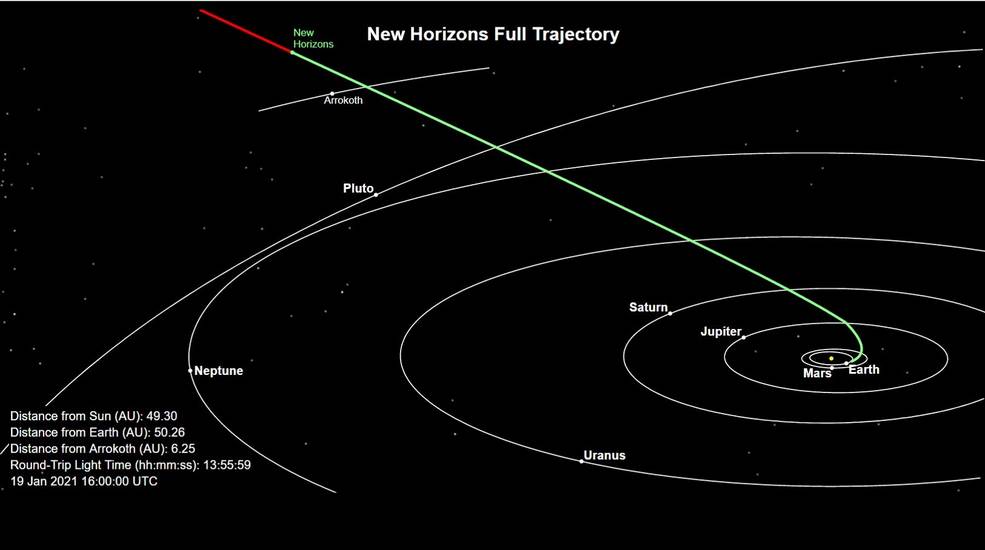
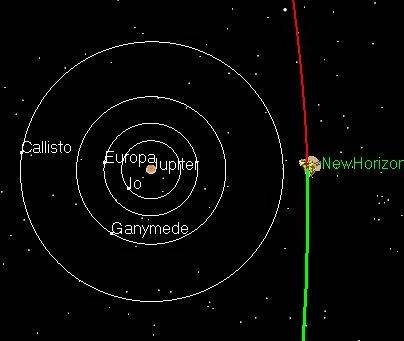
Left: New Horizons’ trajectory through and out of the solar system, with encounters at Jupiter, Pluto and 2014 MU69, later renamed Arrokoth. Right: New Horizons’ trajectory through the Jovian system. Credits: NASA, Johns Hopkins University Applied Physics Laboratory, Southwest Research Institute.
In August 2006, the International Astronautical Union (IAU) made a controversial decision to redesignate Pluto as a dwarf planet, similar to other small objects being discovered in the outer region of the solar system known as the Kuiper Belt. Undaunted by the IAU’s “demotion” of Pluto from full planet status, New Horizons continued toward its first planetary encounter, the gravity assist maneuver at Jupiter. On Sep. 4, 2006, while still 181 million miles away, New Horizons pointed its LORRI toward Jupiter and took its first test photographs, already revealing the bands in the planet’s atmosphere and catching two of its satellites, Europa and Io, passing in front of the planet. The actual encounter phase took place between January and June 2007, with the closest approach occurring on Feb. 28 at 1.4 million miles. Although farther than the previous spacecraft that flew by Jupiter, this was the distance needed for New Horizons to pick up enough speed to get it to Pluto in 2015 and to bend its trajectory toward the distant world.
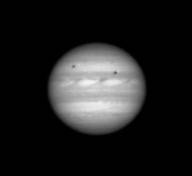
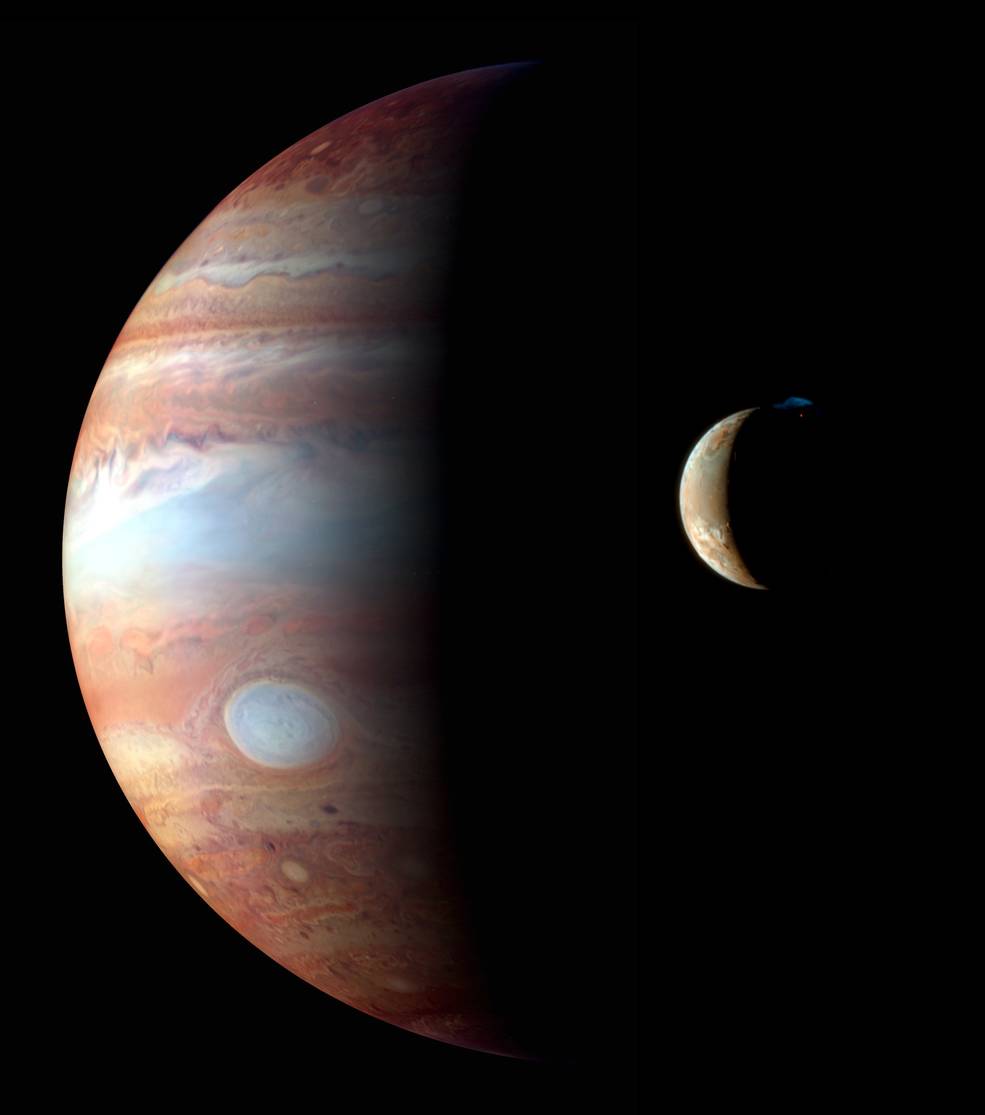
Left: New Horizons’ first image of Jupiter, taken from 181 million miles away, using the LORRI instrument, with the moons Europa, left, and Io and their respective shadows on the planet. Right: Composite image of Jupiter in infrared light and its moon Io, with the volcano Tvashtar caught in the act of erupting, at upper right on Io’s dark limb. Credits: NASA, Johns Hopkins University Applied Physics Laboratory, Southwest Research Institute.
The New Horizons encounter filled a gap in the exploration of Jupiter, with the Galileo orbiter’s mission completed in 2003 and the next orbiter, Juno, not arriving until 2016. The spacecraft’s trajectory positioned it for the best observations yet of Jupiter’s faint rings. Fortuitously, during those studies, New Horizons captured the volcano Tvashtar on Jupiter’s moon Io erupting, with sequential images showing the plume rising to an altitude of 200 miles and falling ballistically back toward the surface. As New Horizons left Jupiter, its trajectory took it down the long tail of the planet’s active magnetosphere. The spacecraft made unique observations as it traveled for 100 million miles down Jupiter’s magnetotail.
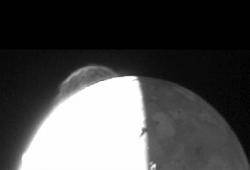
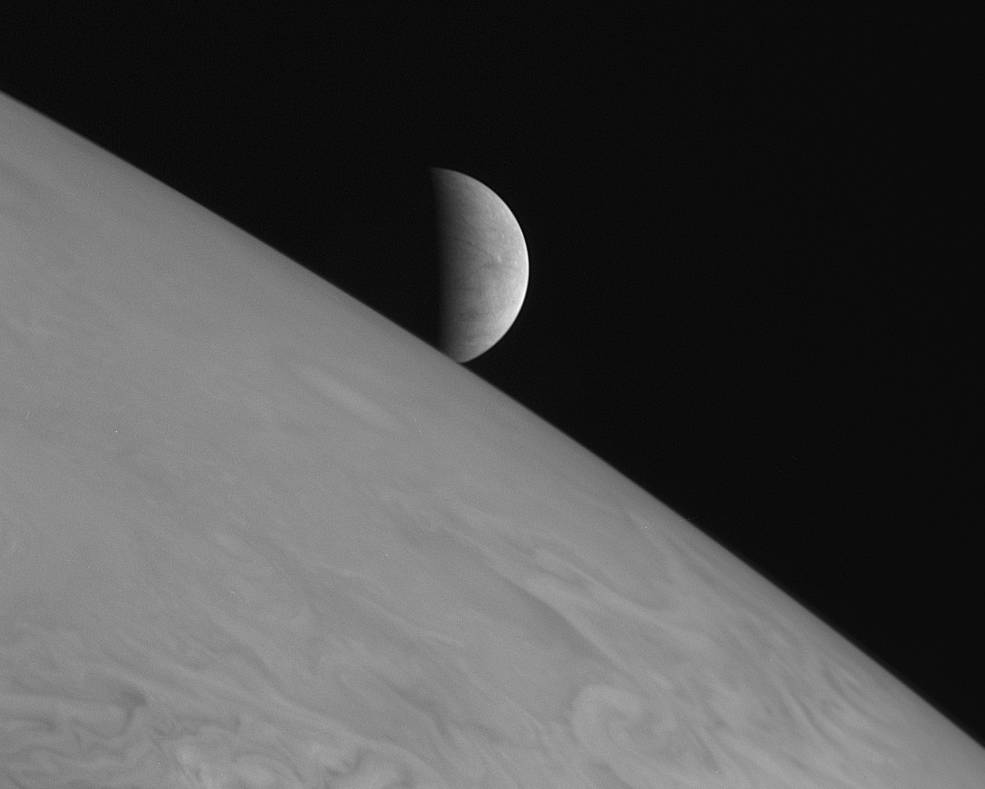
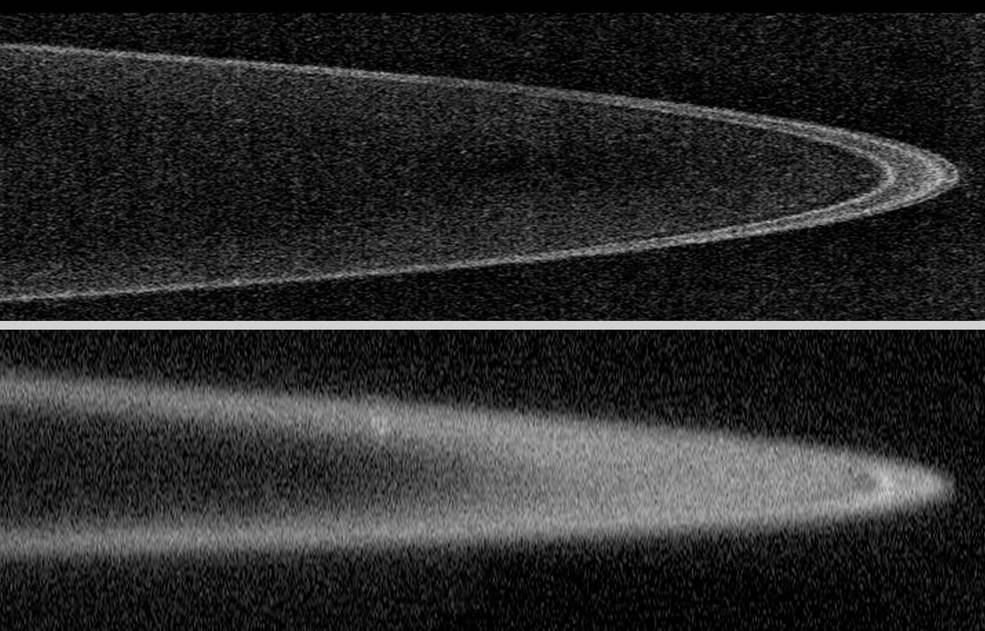
Left: New Horizons image of the plume from Tvashtar, a volcano erupting on the Jovian moon Io, taken from 1.5 million miles away. Middle: New Horizons captured Jupiter’s moon Europa rising above its home planet. Right: Two views of Jupiter’s faint rings taken during New Horizons’ approach to, top, and departure from the giant planet. Credits: NASA, Johns Hopkins University Applied Physics Laboratory, Southwest Research Institute.
After leaving Jupiter behind, New Horizons settled in for the nearly eight-year journey to Pluto. To save wear and tear on the spacecraft’s systems, controllers at APL placed New Horizons in hibernation, first for one week, then gradually extending the quiescent periods to seven months. During this time, controllers began planning the details of the Pluto encounter. They faced challenges since scientists knew relatively little about the planet and its environment. Astronomer Clyde Tombaugh discovered Pluto in 1930 and since its discovery, it had not even completed one-half of a revolution in its 248-year orbit around the Sun. Astronomers discovered the first moon orbiting Pluto in 1978, naming it Charon. They realized the two formed a planetary binary system since Charon was the largest satellite in the solar system relative to its parent body. Pluto and Charon are tidally locked, meaning Charon always presents the same side to Pluto, and furthermore, Charon takes 6.4 days to orbit around Pluto, the exact same time as Pluto rotates on its axis. In 2005, a dedicated effort using the Hubble Space Telescope to find additional moons and possibly rings orbiting Pluto yielded two new satellites, named Nix and Hydra. Scientists discovered two more, Kerberos and Styx, in 2011 and 2012, respectively, with New Horizons already more than halfway to its destination. These four new moons appeared to be small, orbiting beyond Charon’s orbit. To add one more complication to mission planners, Pluto’s axis of rotation is tilted 120 degrees, so like Uranus and unlike all the other planets, it is basically lying on its side. New Horizons’ encounter would be a very fast trip through the bull’s eye, traveling at 52,000 miles per hour.
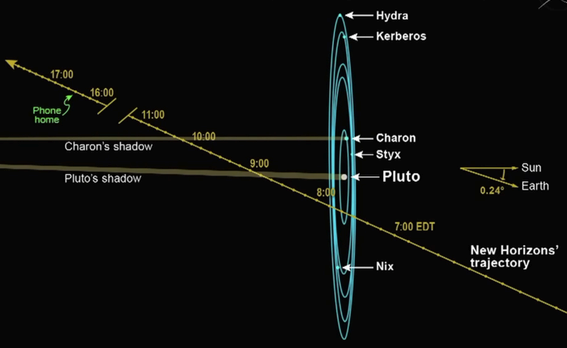
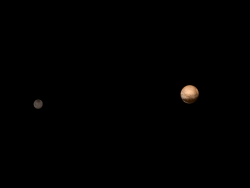
Left: The trajectory, right to left, of New Horizons through the Pluto system during the close encounter phase. Right: New Horizons image of Charon, left, and Pluto from 3.7 million miles away, six days before closest approach. Credits: NASA, Johns Hopkins University Applied Physics Laboratory, Southwest Research Institute.
New Horizons ended its last hibernation period on Dec. 6, 2014, to prepare for its Pluto encounter that began Jan. 15, 2015, with the spacecraft still 200 million miles away. By April, now within 100 million miles of its target, the resolution in New Horizons’ imagery surpassed that from the Hubble Space Telescope. Intensive imaging and other data collection of Pluto and its satellites began in June with the core observations starting seven days before the closest encounter. Because of the rapidity with which the observations of Pluto, Charon, and the other satellites occurred, and because of the nine-hour roundtrip time required for any signals to travel between Earth and the spacecraft, the entire close encounter data collection sequence was programmed into New Horizons’ computer to execute automatically. On July 4, just 10 days before the closest approach, as controllers uplinked the computer program, they lost contact with the spacecraft. Apparently, the computer became overloaded and sent the spacecraft into a safe mode. With just hours to spare, controllers regained contact with New Horizons and uplinked the commands a second time. At about that time, the spacecraft downlinked to Earth a set of “fail-safe” data, the latest images and science data it acquired before beginning the close encounter data acquisition during which it turned its antenna away from Earth. This fail-safe data, which controllers likened to the contingency lunar samples that Neil Armstrong collected upon first stepping on the Moon, ensured that should something happen to New Horizons during the close approach to Pluto, some data would be salvaged. As it turned out, this batch of data included the iconic image of one entire hemisphere of Pluto, with its famous heart-shaped landmark.
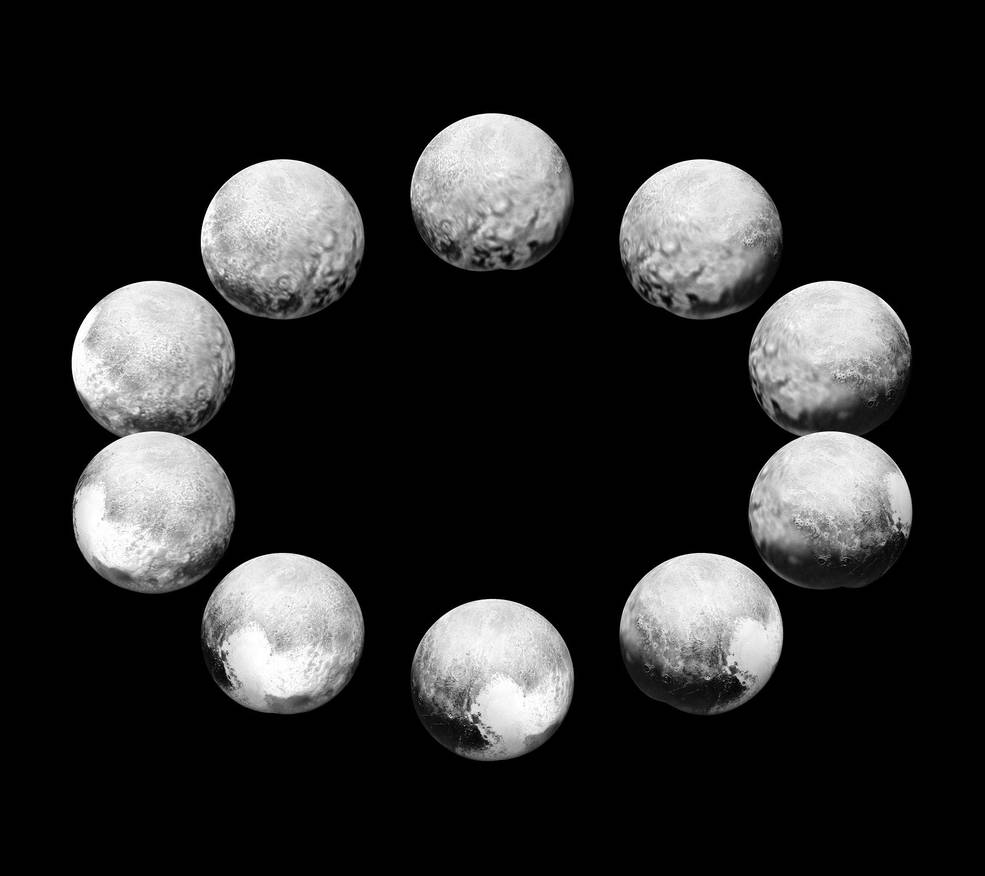
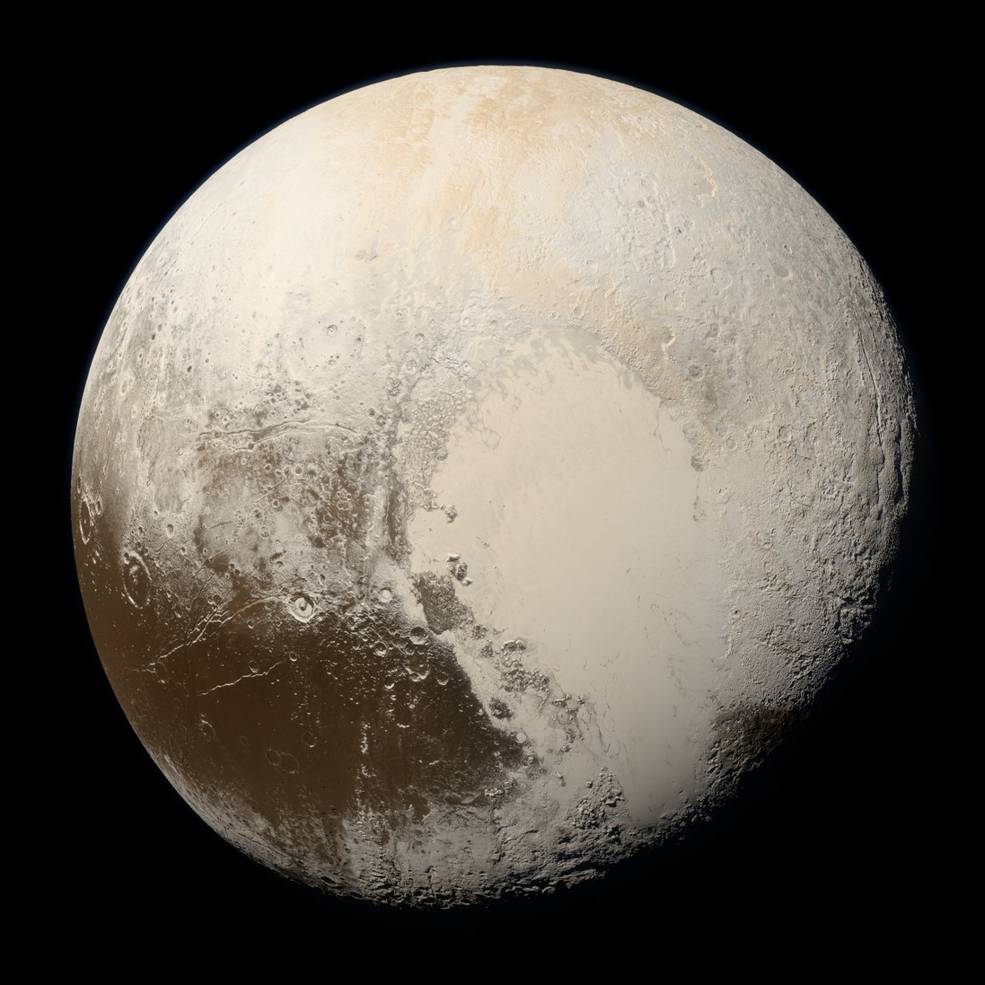
Left: A composite of New Horizons images taken during the final week before close encounter to show all sides of Pluto. Right: A true-color image of Pluto from 22,025 miles away during the approach. Credits: NASA, Johns Hopkins University Applied Physics Laboratory, Southwest Research Institute
Over the next thirty hours, New Horizons completed 236 separate scientific observations of all six bodies in the Pluto system using all seven of its instruments. On the morning of July 14, 2015, it passed within 7,800 miles of Pluto. By coincidence, the New Horizons flyby of Pluto occurred exactly 50 years after Mariner 4’s pioneering exploration of Mars. That evening, the spacecraft turned its antenna back toward Earth and phoned home to relieved controllers and scientists that it had completed all its objectives during the close encounter. Then began the time-consuming task of radioing all the science data back to Earth, a process that took 15 months.
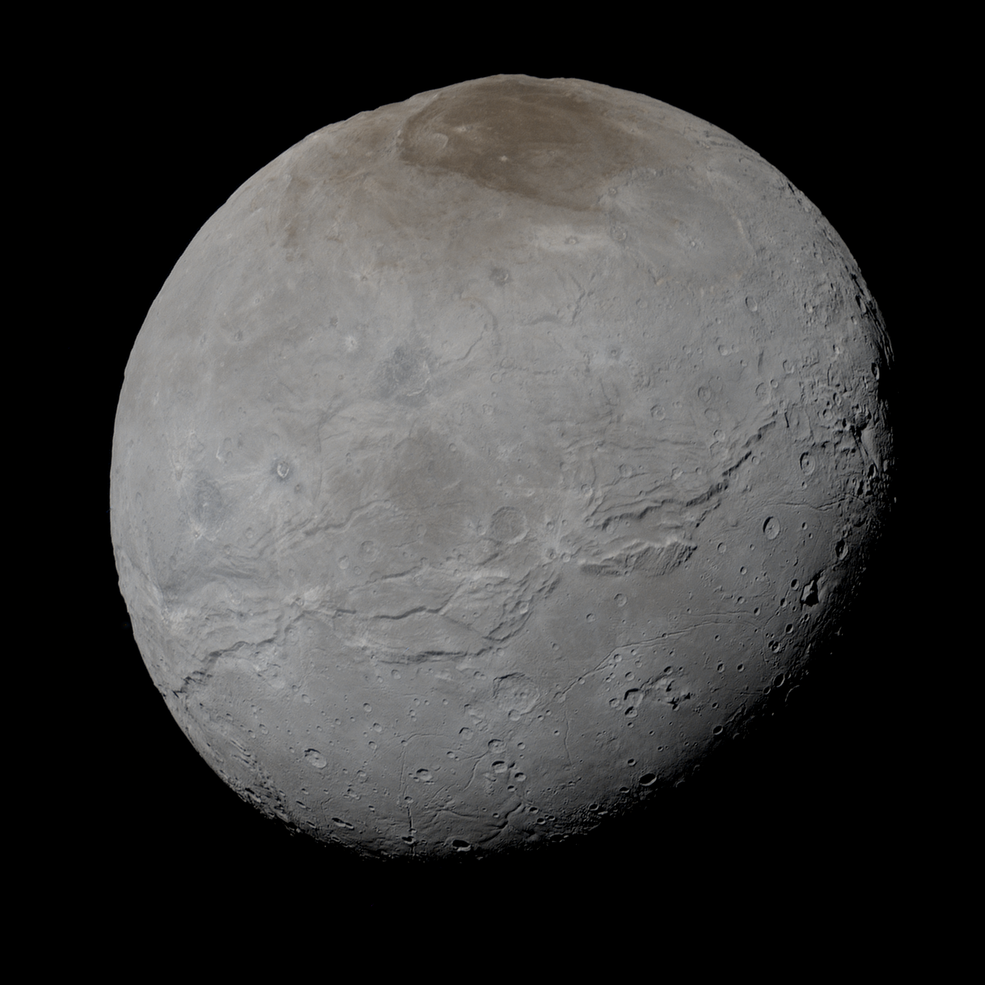
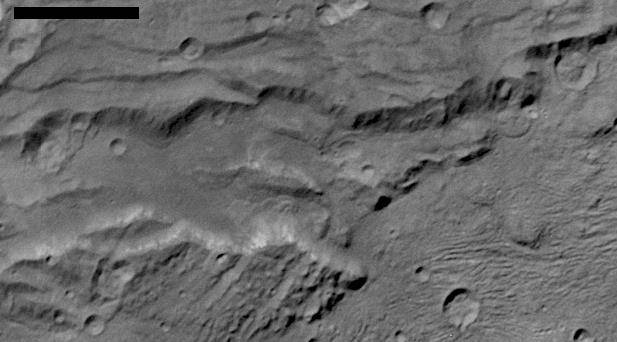
Left: A true-color image of Pluto’s large moon Charon taken from 46,091 miles away. Right: Close-up image of Charon’s surface, showing evidence of past landslides. Credits: NASA, Johns Hopkins University Applied Physics Laboratory, Southwest Research Institute.
The New Horizons images and data surprised scientists by showing both Pluto and Charon to be complex bodies despite their small size and cold temperatures. With relatively few impact craters, both objects displayed relatively recent geologic activity, including nitrogen ice glaciers, mountains, and even ice volcanoes on Pluto and large valleys and cliffs on Charon, indicating tectonic activity and hinting at a possible subsurface ocean.
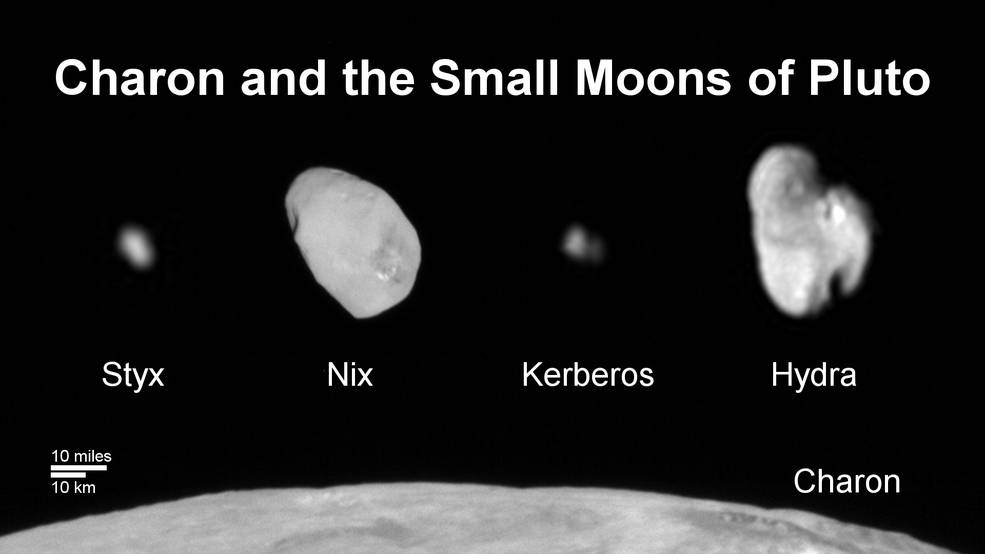
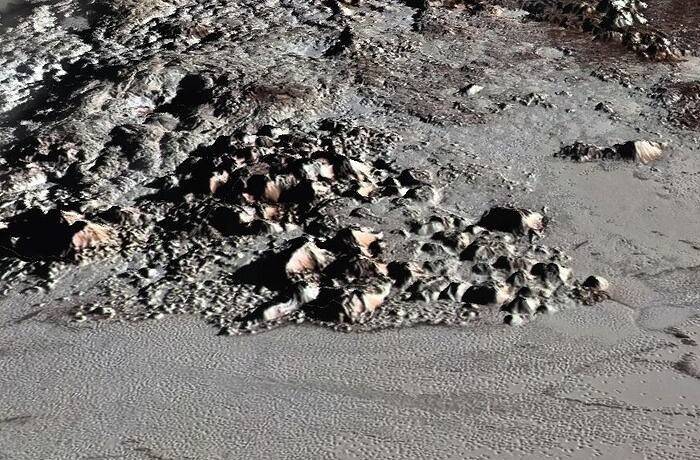
Left: Composite image of Pluto’s five moons, shown to scale. Right: Close-up view of Pluto’s highest mountains, rising 3-6 kilometers above the nitrogen-ice plains in the foreground. Credits: NASA, Johns Hopkins University Applied Physics Laboratory, Southwest Research Institute.
Pluto’s small satellites, although imaged at varying resolutions, surprised scientists by their rapid rotation rates. Hydra, the most extreme, rotates once every 10 hours. All four small moons have elongated shapes and highly reflective surfaces, typical of small icy objects. Perhaps most surprising, Pluto’s atmosphere displayed extensive, well-organized haze layers and a dramatically lower escape rate than expected. Analysis of all the returned scientific information continues, as the new data answers some questions and raises many more, awaiting the next spacecraft exploration.
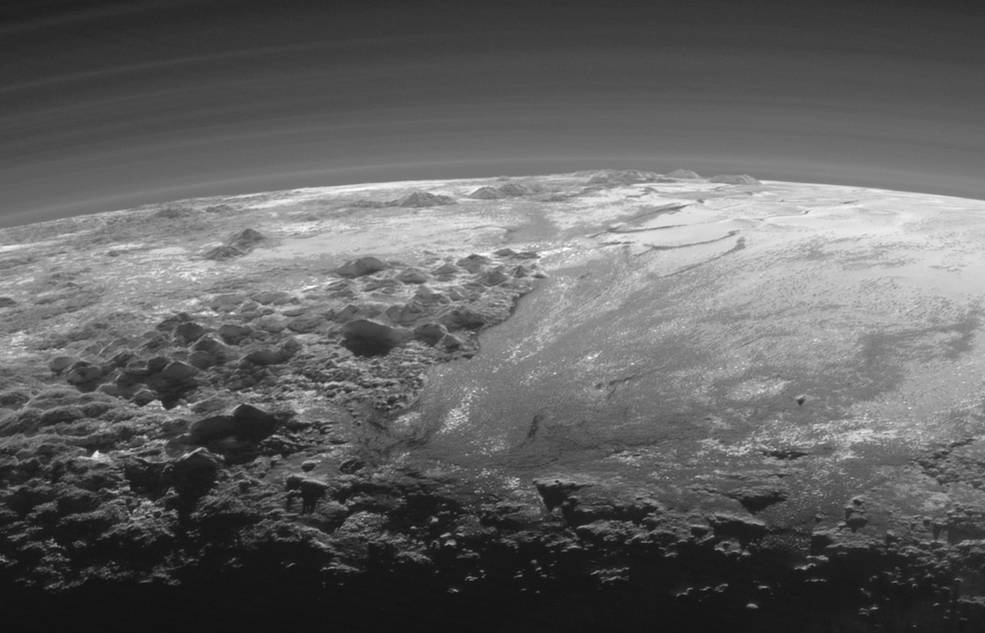
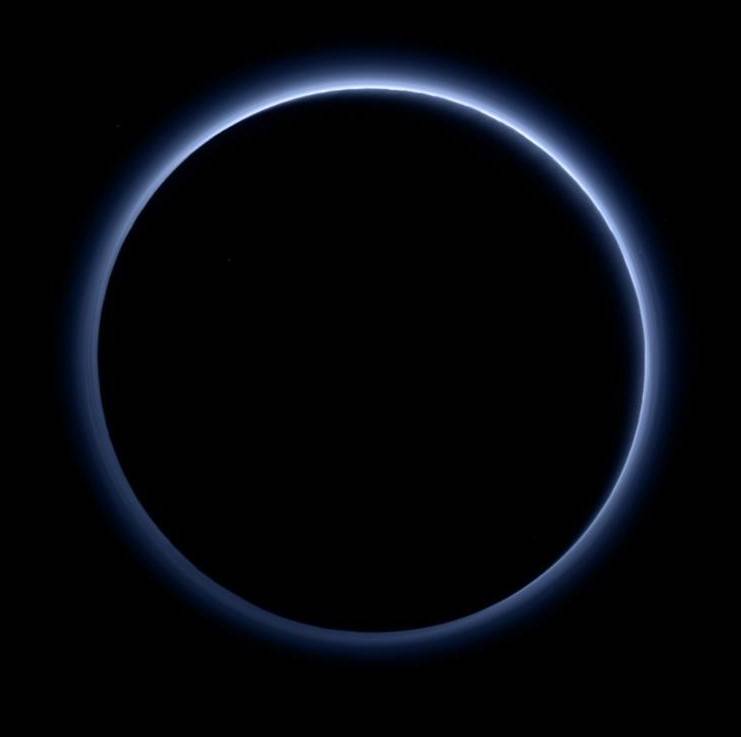
Left: An image taken just 15 minutes after closest approach shows a setting Sun highlighting mountains and haze layers above Pluto’s surface. Right: In an image taken 15 hours after closest approach and from 480,000 miles away, solar backlighting reveals Pluto’s haze layer. Credits: NASA, Johns Hopkins University Applied Physics Laboratory, Southwest Research Institute.
During a post-encounter press conference, PI Alan Stern and his team members held up an enlarged version of the 1991 postage stamp that indicated that Pluto had not yet been explored, with the words “NOT YET” crossed out. In 2016, the U.S. Postal Service issued another set of stamps, with updated images of the planets from more recent spacecraft encounters, including a set with images of Pluto and its first explorer, New Horizons.
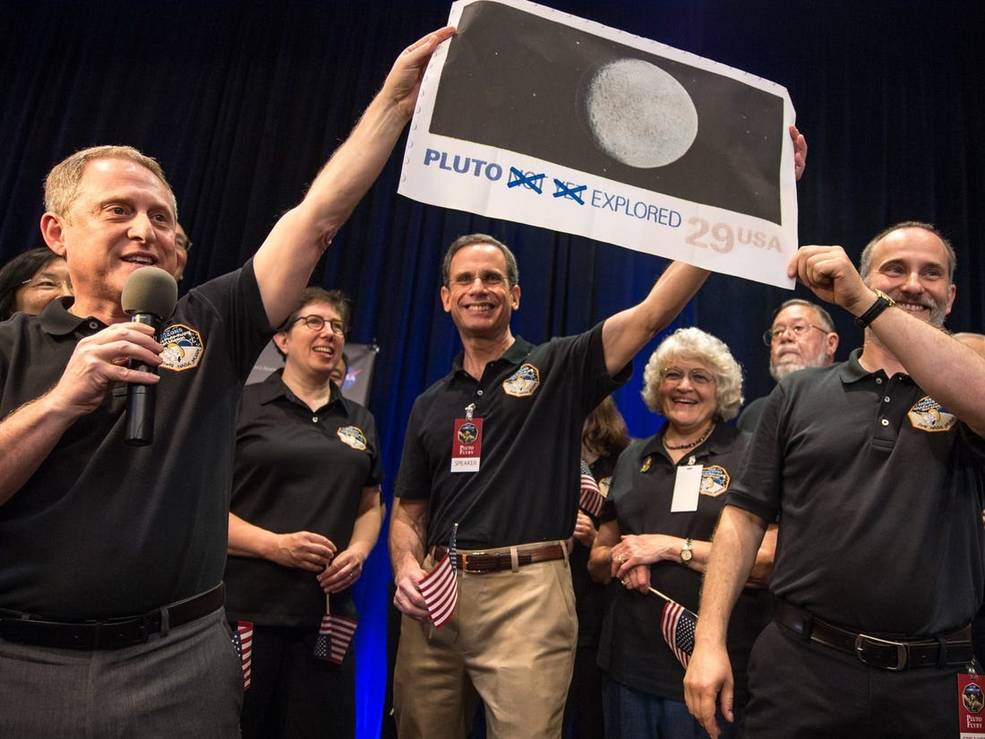
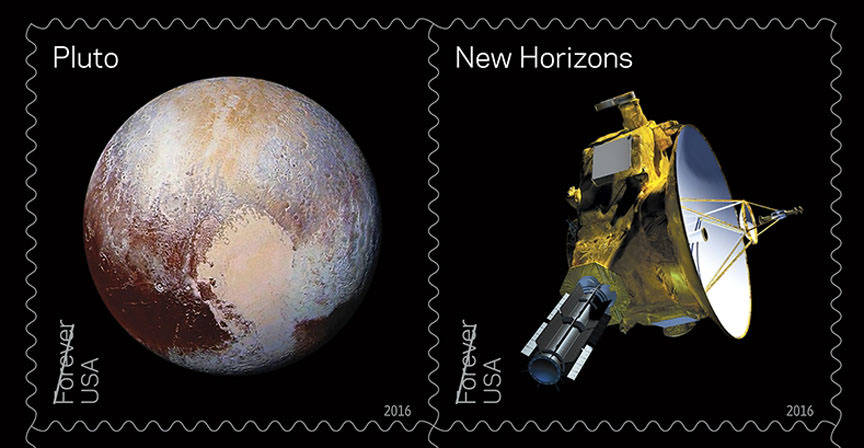
Left: At a press conference following the Pluto encounter, New Horizons Principal Investigator Alan Stern, left, Ralph Semmel, director of the Johns Hopkins University Applied Physics Laboratory, and team member Will Grundy hold up an enlarged version of the 1991 Pluto stamp, with the words “NOT YET” crossed out. Right: The U.S. Postal Service released a new stamp of Pluto in 2016 to commemorate the New Horizons encounter. Credits: NASA, Bill Ingalls, U.S. Postal Service.
In 2011, mission scientists began a search using the Hubble Space Telescope for objects in the Kuiper Belt as targets for New Horizons to explore following its encounter with Pluto. On Aug. 28, 2015, they selected an object designated 2014 MU69, about one billion miles beyond Pluto, as New Horizons’ next destination. So little was known about this object, nicknamed Ultima Thule by the mission team, that controllers used images from New Horizons to navigate the spacecraft to its vicinity. The spacecraft made its first observation of the remote object on Aug. 16, 2018, at a distance of 107 million miles, with Ultima Thule appearing only as a tiny dot. Even up to 24 hours before the closest approach, it appeared as just an elongated shape. On Jan. 1, 2019, New Horizons zipped by Ultima Thule at a distance of 2,198 miles, traveling at 32,000 miles per hour. Close up images revealed a contact binary object, composed of two objects 13 miles and 9 miles across, joined at their longitudinal axis, and a reddish-brown color. The larger lobe appeared to be composed of about eight smaller objects aggregated together. Data from New Horizons revealed that Ultima Thule rotates on its own axis every 16 hours. After completing the most distant spacecraft encounter in history, New Horizons continued on its path through the Kuiper Belt and ultimately out of our solar system. The data it collected at Ultima Thule took 20 months to beam back to Earth. New Horizons continues to make distant observations of Kuiper Belt Objects, but no close encounters are currently planned.
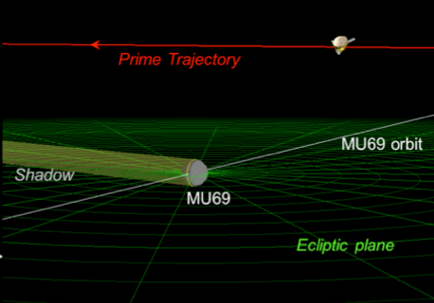
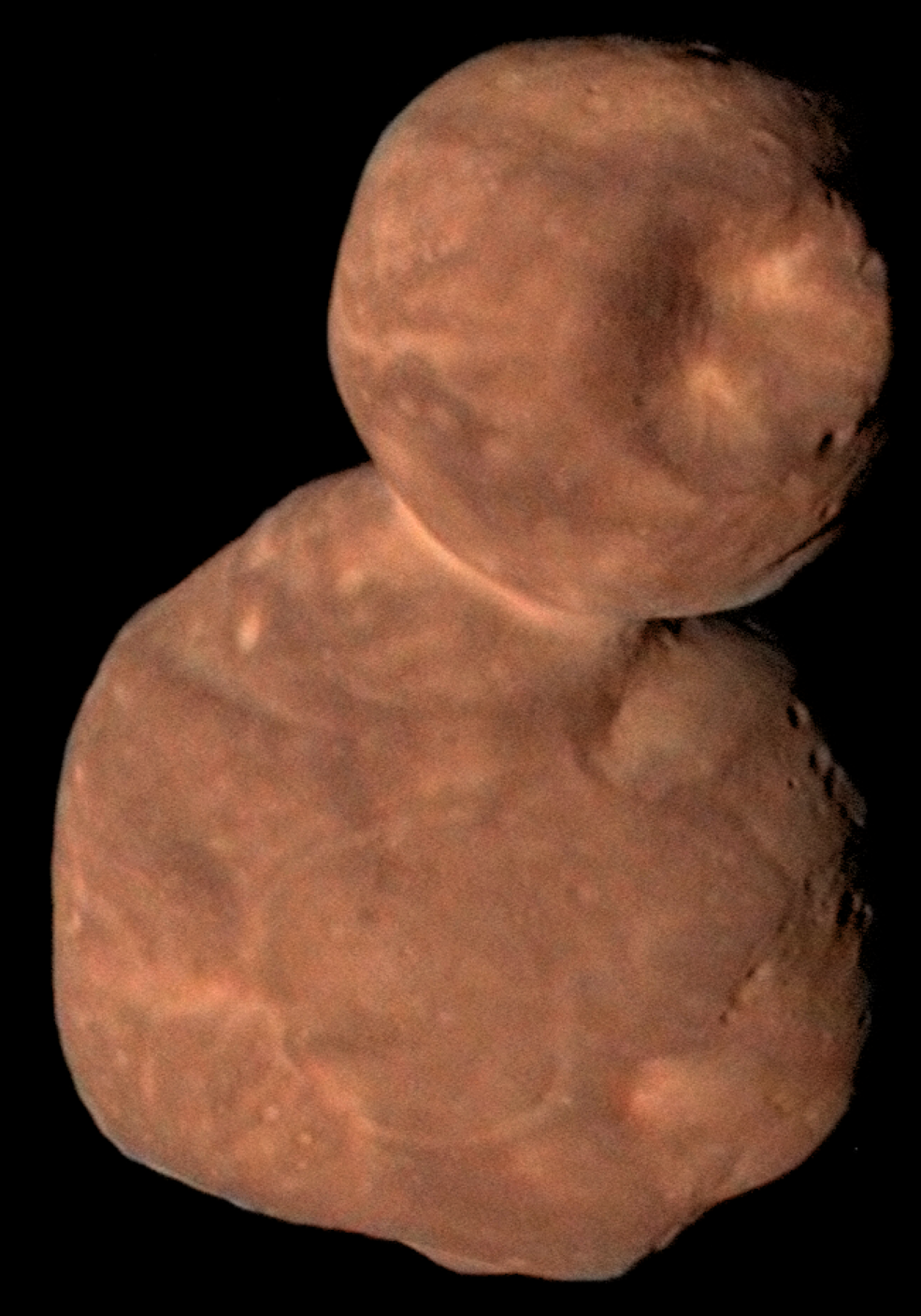

Left: New Horizons’ trajectory, right to left, past the Kuiper Belt Object 2014 MU69, later renamed Arrokoth. Middle: New Horizons image of Arrokoth from 10,300 miles away. Right: New Horizons image taken from 5,494 miles beyond Arrokoth, backlit by the Sun. Credits: NASA, Johns Hopkins University Applied Physics Laboratory, Southwest Research Institute.
On Nov. 12, 2019, in a ceremony held at NASA Headquarters in Washington, D.C., 2014 MU69 was officially renamed Arrokoth, a Powhatan Algonquian word relating to the sky, to honor the Powhatan people on whose traditional land APL sits. The naming ceremony took place with the consent of the Powhatan people, with the Rev. Nick Miles of the Pamunkey Tribe participating. A model of New Horizons is on display at the Smithsonian Institution’s National Air and Space Museum Stephen F. Udvar-Hazy Center in Chantilly, Virginia.
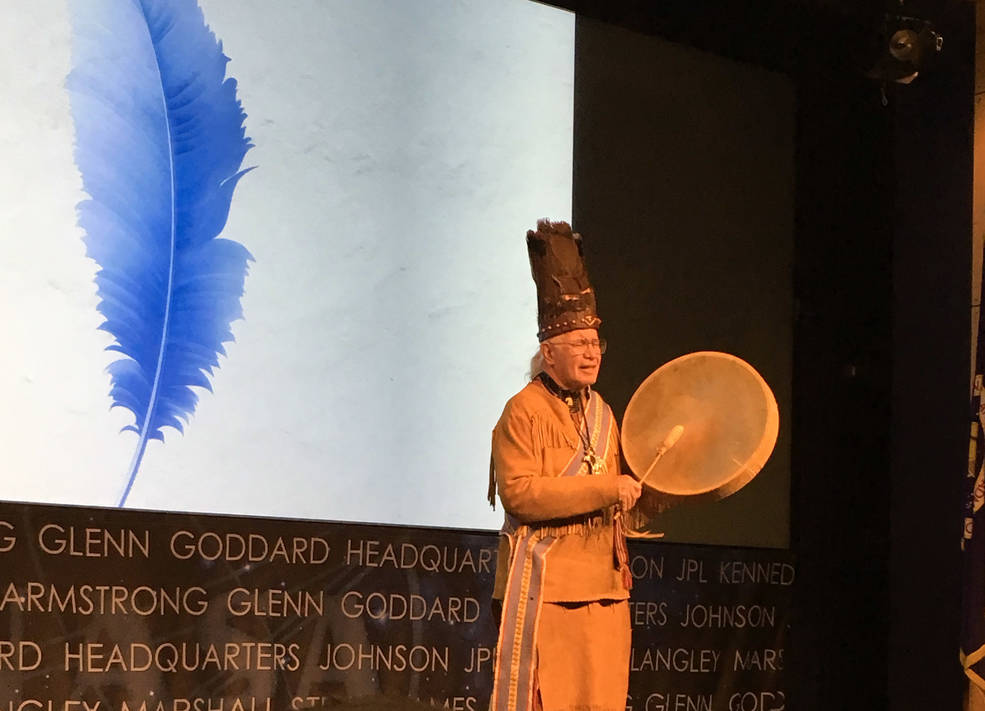
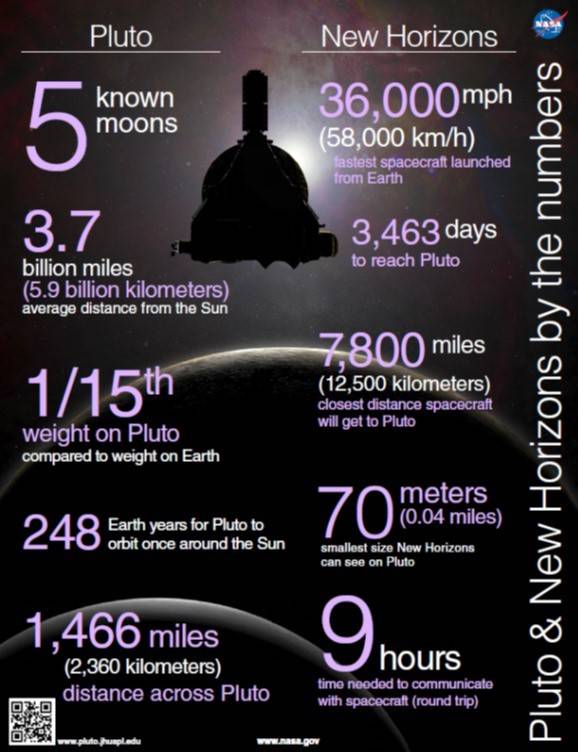
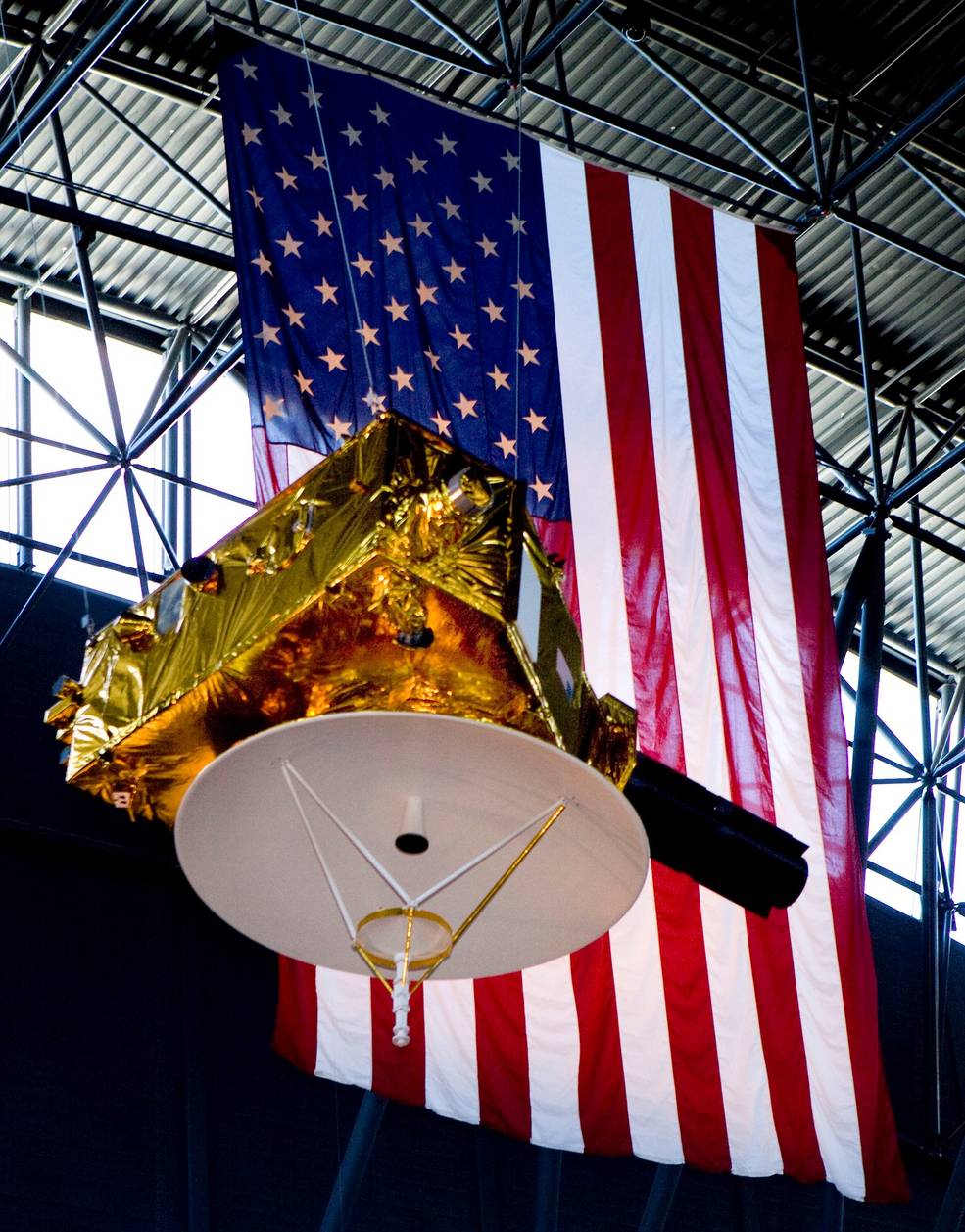
Left: Rev. Nick Miles of the Pamunkey Tribe participating in the Arrokoth naming ceremony at NASA Headquarters. Middle: New Horizons’ Pluto encounter by the numbers. Right: Model of New Horizons on display at the Smithsonian Institution’s National Air and Space Museum Stephen F. Udvar-Hazy Center in Chantilly, Virginia. Credits: NASA, Johns Hopkins University Applied Physics Laboratory, Southwest Research Institute.










